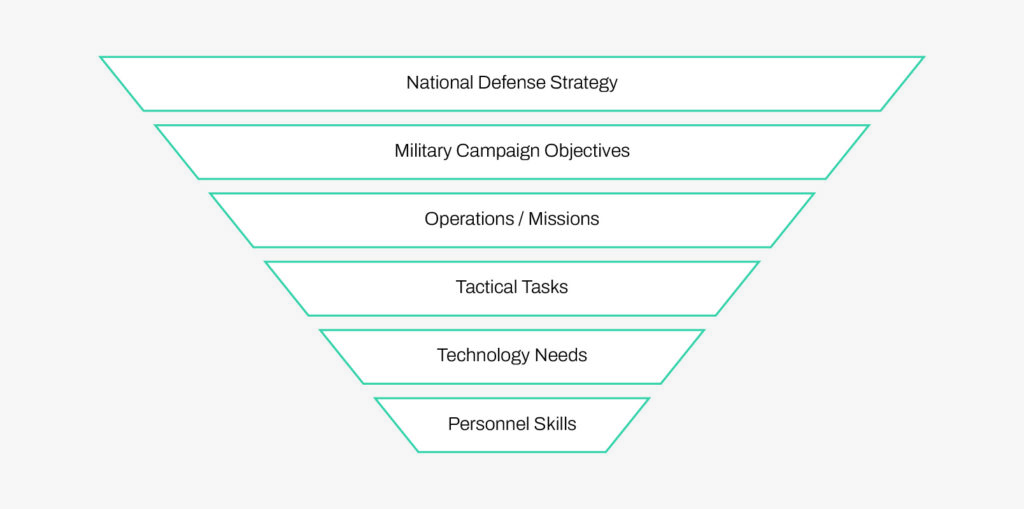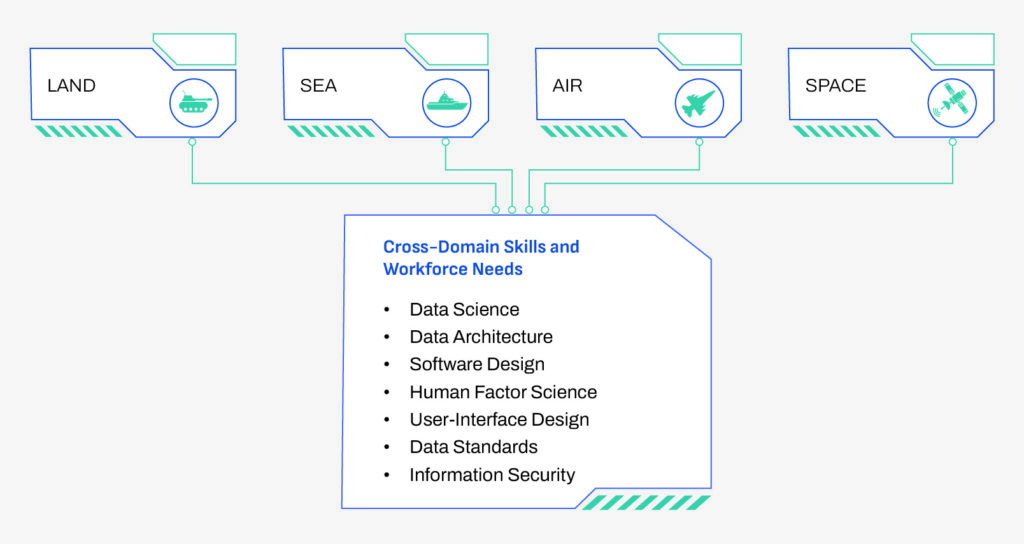Introduction
Future warfare paradigms envision the use of emergent technologies and a workforce with new types of skills. This paper begins with a brief discussion about the changing landscape for high-priority military operations and the challenges of identifying future technology and workforce needs for the air force. Introducing the strategies-to-tasks approach as a guiding framework to connect national defense strategy with mission-level roles, this paper explores how such an approach plays out in practice and can be used to address emerging competencies and workforce requirements. Finally, this paper analyzes potential obstacles and the cultural shifts necessary for effective implementation, posing important questions to air power leaders about the broader transformations required beyond technology and workforce upgrades to adapt to future warfighting paradigms.
The Changing Landscape and Adapting to Future Warfare
Military futurists envision new approaches to warfare that can leverage emergent technologies, such as hypersonics, quantum computing, additive manufacturing, and machine learning/artificial intelligence. It is less understood how these technologies can be applied to specific high-priority military operations and what kind of workforce will be needed to acquire, operate, and sustain the human use of these applied technologies. To evolve to the envisioned future warfighting paradigm requires a fresh review of capability needs, based on a strategies-to-tasks approach, to identify the future technology and workforce needs (Thaler, 1993). Long-term planning for military capabilities is anchored in a national defense strategy. Such a strategy sets the objectives for military forces in the context of whole-of-government priorities, adversaries, partners, and allies. A similar approach used for aircraft, ship, or tank force structure planning could be applied to identify and plan for future technologies and workforces.
A review of U.S. national defense strategy with an air component lens identified several mission areas and their sometimes fluctuating priorities: air superiority and strike in contested environments, along with the supporting intelligence, surveillance, and reconnaissance (ISR) missions; an increased relevance of nuclear missions; an overall increase in demand for missions in the Indo-Pacific; a de-prioritization of missions to counter violent extremist organizations; and space superiority. Guidance from the national defense strategy is one input for identifying technologies and personnel needs for modern warfare. Another input is an examination of future warfighting trends. Research at RAND and elsewhere has identified several such trends: the growing diversity of missions, the growing diversity of domains, the growing importance of the information domain, an increased emphasis on precision and automation, and an increased potential for humanitarian assistance and disaster relief.
The intersection and interaction of the two—that is, the air component’s missions in support of national defense strategy and the future warfighting trends—paint a picture of what will likely be needed to compete effectively in modern times. A strategies-to-tasks approach directly links national-level guidance and strategy to mission-level roles and responsibilities that are then divvied among the military service components. Further decomposition of the mission-level roles into tactical tasks can further help sketch out the future force needs in terms of technologies, organizations, policies, and personnel, as depicted in Figure 1.

For an illustrative vignette of how this approach could unfold, imagine that your national strategy includes being strategically prepared for natural disasters, given that their intensity and frequency have increased. Furthermore, the strategy identifies key partners for your country. In this vignette, a nearby country experiences a natural disaster. This country is mentioned in your national defense strategy as a target country with which to strengthen relationships. Your government expresses an immediate commitment to provide the needed resources in response. Your air forces may provide several functions to your government to fulfill this commitment. These functions may include airlift to move cargo, aeromedical evacuation, ISR assets to survey the damage, local and beyond-line-of-sight communications, provision of government and non-government organization supplies, civil engineering, logistics, and security forces. These functions represent operational capabilities provided by the air component.
It is important to think not about how these functions are executed today using older technologies that were purchased likely decades ago and using tactics that were learned in training likely decades ago. Rather, one should think about how the functions could be executed using new technologies and new ways of doing business empowered by those new technologies. While individuals may successfully adapt new technologies to old processes, an organization as a whole may miss out on an opportunity to improve overall mission effectiveness. One opportunity could be to improve supply-chain management by leveraging emerging technologies, such as additive manufacturing (to generate supply) or drone delivery (to meet demand). Another opportunity could be to pull commercial satellite imagery down to the disaster response headquarters to identify pathways and obstructions to the affected areas and to pair the satellite imagery with publicly available information to alert first responders to the evolving situation. Currently, the roles for imagery tasking, collecting images, and data sharing could cut across multiple organizations or functions across the joint forces, whereas newer, integrated processes could further improve and accelerate mission outcomes.
The illustrative vignette points to some emerging competencies that will be needed for future operations. Additive manufacturing and drone delivery are newer technologies that are not yet tailored for military applications. Harnessing these technologies for military applications could require additional skills in cyber security, piloting drones, and software coding. Similarly, other military competencies will likely be needed in contracting, information technology, engineering of ruggedized user equipment, cross-domain ISR collection management, open-source intelligence, foreign-language translation, information operations (e.g., public affairs monitoring of social media), dynamic battle management, and tactical command and control (C2).
Whereas this hypothetical example of a natural disaster suggests some of the ways in which military missions and workforce needs could change in response to a particular kind of future emergency, a broader perspective on technological trends suggests how they could alter most or nearly all future military operations. As described in the strategies-to-tasks approach outlined above—with mission roles and responsibilities allocated among the military service components along the lines of the air, sea, and land domains—the critical task (and skill) of planning and executing these operations will come down to the coordination and deconfliction among the domain component commanders. The task has grown all the more critical because, with the evolving modern warfare concepts, the distinctions between the domains have blurred—air forces providing counter-maritime capabilities, land forces with long-range artillery, and drones operating in the same air space used by manned aircraft, including naval aircraft, and so on. Furthermore, each of the traditional land, sea, and air domains seeks to leverage the increasingly salient space, cyber, and information domains. The successful execution, coordination, and deconfliction of true multi-domain operations will mandate a tighter coupling of all of these domains. This coupling must be enabled by shared, seamless, cross-domain intelligence underpinned by common data and cross-domain accessibility to those data.
While individuals may successfully adapt new technologies to old processes, an organization as a whole may miss out on an opportunity to improve overall mission effectiveness.
– Dr. Sherrill Lingel
Navigating the Path to a New Warfighting Paradigm
This new environment creates a new demand signal for a workforce not previously needed in the military. Data scientists, data architects, software designers, human factor scientists, and user-interface designers are career fields that have previously been atypical within the military. While the technology industry has grown these career fields over the past decade or so, this workforce is not familiar with the military context or demand for their skills. In some instances, the members of this workforce have shown that they do not want to work with the military. Whether a military service contracts out for these capabilities or grows its workforce to incorporate these capabilities is a decision that will be based on many factors related to budgets and recruitment. Regardless of the path taken moving forward, the need will remain for these skills. As depicted in Figure 2, these skills will be needed to erect, uphold, maintain, and continually repair and upgrade the multi-domain digital infrastructure for connecting pertinent related data, establishing standards for data storage, tagging data for maximum integration and utility, sharing data, and interfacing with humans who ultimately will make the military decisions based on the data. More sophisticated data analytics could soon become necessary. The addition of artificial intelligence and machine learning into military systems and capabilities could further expand the range of required technologies and necessary skills.

Building out this multi-domain digital infrastructure will spur additional demands. New software must go through test and evaluation. Operators or end-users must be trained. Relying on more software and hardware for mission execution creates a larger cyberattack threat against which cyber defense plans must be developed and put in place. Military operators need to be educated to understand the emerging capabilities in other domains within the multi-domain kill chains. Capabilities must be acquired at a faster pace to leverage technology developments, which means that acquisition processes may also need to change. This new way of developing cross-domain capabilities and skills for planning and executing a multi-domain war is, in many ways, a stark contrast with the traditional military ethos of top-down command within each service or domain. At the same time, the air component, in particular, prides itself on being agile and flexible—which are core characteristics and tenets of air power. So, then, how can the air component adapt and be agile and flexible to adjust to meet the demands of modern warfare?
It is broadly acknowledged that current military organizational structures, personnel skills, and processes are insufficient to enable modern warfare to move at the speed and scale necessary to prevail in a conflict.
– Dr. Sherrill Lingel
It is broadly acknowledged that current military organizational structures, personnel skills, and processes are insufficient to enable modern warfare to move at the speed and scale necessary to prevail in a conflict. The U.S. Department of Defense’s data strategy clearly articulates a vision for using data “at speed and scale for operational advantage and increased efficiency.” Several of the technological skills needed to improve disaster relief in peacetime will be necessary to expedite military operations in wartime as well. In all cases, the air component will need a workforce capable of not only executing mission goals, but also sustaining the mission capabilities. The strategies-to-tasks approach provides a structure for identifying and pursuing the workforce modernizations needed for the short-term, medium-term, and long-term. The modernizations required for the new warfighting paradigm could extend beyond technology and workforce upgrades. Additional improvements could be required in three key areas: (a) how the air component is organized, (b) the policies currently in place (for example, on information sharing or engagements), and (c) the training provided to the workforce. Key questions to consider in these areas include the following:
▪ What barriers exist to executing our mission based on the way we are currently organized? Does our current organizational structure give us unity of command?
▪ What barriers exist to executing our mission based on our policies? Do our security policies and the ways they are implemented permit or hamper the execution of our mission? What policy changes are needed within and outside of the air component to lower our barriers to execution?
▪ Do we have the necessary training (the material and courses) to prepare the workforce for our mission? How often and by what means is our training updated?
Even if these barriers can be surmounted, the highest barrier of all to overcome may be cultural. Organizational culture can impede progress. Recent RAND research has found that existing organizational culture, legacy policy structures, and current limitations in data infrastructure stand out as barriers to fully leveraging emerging technologies for the purposes of Human Resource Management, and likely these barriers exist for other purposes as well. (Schulker, Walsh, Lim, and Kochhar, 2022). All stakeholders will need senior leaders to become champions of change, to provide guidance throughout the process of change, to offer success stories to demonstrate the value of changes that leverage new technologies, to create buy-in, and to empower change agents. RAND work for the Army developed a framework of culture change driven by five factors: goals, accountability, training, resources, and engagement. (Meredith and Lisa, 2017)
Conclusion
As with the other aspects of a strategies-to-tasks approach, organizational and cultural change will need a strategy and a plan. Both private-sector and military interviewees in recent research have said that “the alignment of funding, priorities, and people were essential to a successful transformation, and reported that the support of senior leadership was invaluable in achieving that alignment.” The human factor of organizational change management cannot be overstated. Keeping key senior leaders informed about the changes being made and having those individuals become key elements of the change management process can be powerful drivers of change. With respect to technological upgrades, an incremental and deliberate approach to executing them can provide several advantages. Incremental improvements provide early, achievable wins. They synchronize technological progress with available funding, thus supporting a transition plan with a funding plan. And they enable the incremental phasing out of legacy programs. Incremental changes coupled with experimentation and assessments can serve as a feedback mechanism to improve further iterations. Another key element of organizational change management is a communications plan to prepare the stakeholder base for transformation. The stakeholder base—that is, the audience of the communications plan—includes acquisition, doctrine, operations, intelligence, training, and science and technology personnel. The communications plan needs to address this audience and provide mechanisms for their feedback. Engaging the stakeholder base regularly in the transformation process can generate buy-in and help mitigate resistance to change. In particular, convening engagements to elicit from the operators and users of existing methods of mission execution what they believe are the most valuable attributes of those existing methods can identify potential barriers to adoption of new methods. Incorporating these valuable attributes in new technologies and new ways of operating can mitigate potential pushback from users.
Changing from current systems and methods to a new warfighting paradigm may appear to be a daunting challenge. A strategies-to-tasks approach that extends to technological and workforce advancements can be a powerful framework for motivating and focusing the air component enterprise toward its goals. This approach provides a mission focus for the broader stakeholder base. An effective communications plan can support the larger organizational change management strategy, and incremental milestones can ensure steady progress.
References
Meredith, Lisa S., et al. (2017) ‘Identifying Promising Approaches to U.S. Army Institutional Change: A Review of the Literature on Organizational Culture and Climate.’ Rand, 5 December.
Available at: www.rand.org/pubs/research_reports/RR1588.html
Schulker, D., Walsh, M., Lim, N. and Kochhar, A.K. (2022) ‘How the U.S. Air Force Can Incorporate New Data Technologies into Its Talent Management System: Framework and Use Cases for Technology-Enabled Talent Management,’ Rand,
Available at: https://www.rand.org/pubs/research_reports/RRA1198-2.html
Thaler, D.E. (1993) ‘Strategies to Tasks: A Framework for Linking Means and Ends,’ Rand,
Available at: https://www.rand.org/pubs/monograph_reports/MR300.html
U.S. Department of Defense, DoD Data Strategy, 2020
Yeung, D., et al. (2022) ‘Implementing Technology-Enabled Human Resources Capabilities in the U.S. Air Force: Insight from the Private Sector and Military Services,’ Rand, 21 December. www.rand.org/pubs/research_reports/RRA1198-1.html








